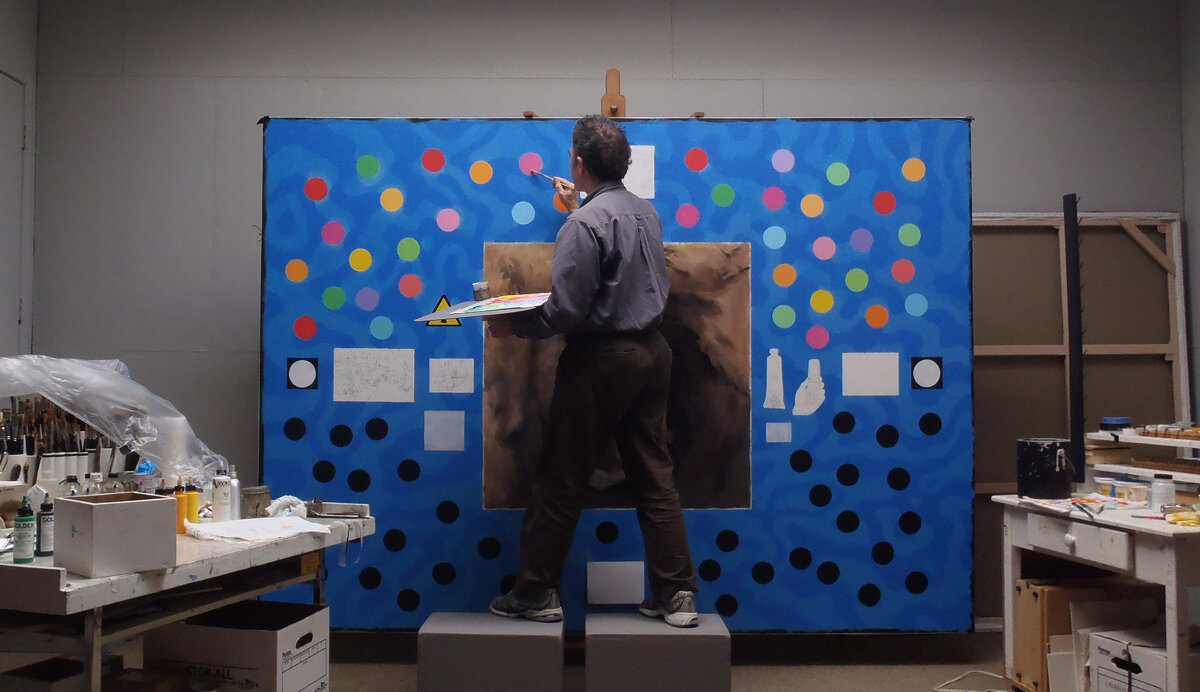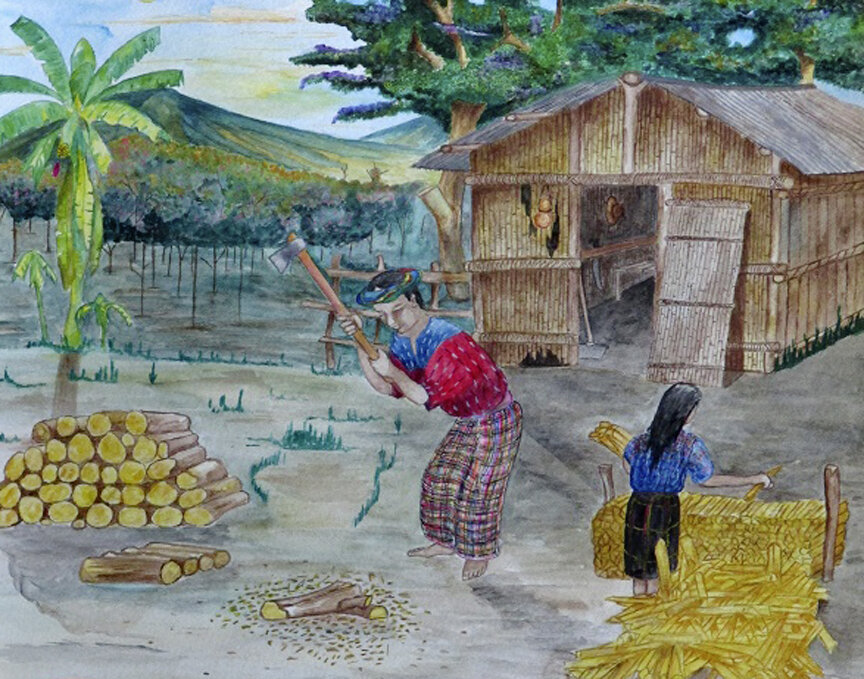Supply Chain Portraits -The Project
Pipeline
I began work on Pipeline, the first of my Supply Chain Portraits series, in 1998 after reading a CNN news report about a gasoline pipeline explosion that killed hundreds of people in the small rural village of Jesse in the oil-rich Niger Delta of Nigeria in West Africa. The story ended by stating that “the charred remains of one woman were found with her dead baby strapped to her back.”
The horror of that tragic image was overwhelming to me because at that time in my life I had recently become a father, and my wife often carried our own precious baby around on her back in a cloth sling. I could not imagine the anguish of losing one’s wife and child, along with friends and neighbors, in such a terrible event.
Could this possibly be part of the price paid for the gasoline in my car? What was this evil supply chain that resulted in death, environmental degradation, and political violence?
Could there be an alternative supply chain supporting life, health, and social justice? I hoped to find understanding or at least a reconfiguration of these existential questions through a new direction in art.
DETAIL: Self Portrait at a Gas Station in the USA. 2002. Oil on canvas 5 inches x 5 inches
DETAIL: Standing on Polluted Ground. Oil on canvas. 6 inches x 9 inches
Pipeline at Rainforest Action Network meeting, Oakland, California, 2006
Family Trees
Four generations of my family have sat down together to share meals at a honey-colored wooden table that stands in the center of our dining room. The table was purchased years ago at a local import furniture store. On its underside is stamped a label reading “MADE IN MALAYSIA.”
DETAIL: Father and Son Eating Cookies. Oil on primed paper. 6 inches x 9 inches
I often sit at the table while reading and one day came across a small black and white photograph in a magazine showing a Penan tribal leader crouching upon an enormous tree stump in the jungles of Malaysian Borneo, staring pensively into the forest, with a child by his side. I was deeply moved by the picture and curious to learn the story of that man and child on the tree stump and how it connected to my own. Thus began an artistic journey around the world to understand where my wooden table had come from.
While researching the photograph I learned about The Borneo Project, a non-governmental organization (NGO) that supports indigenous rights and environmental protections in Borneo. I soon became a member and for the past several years have served on the organization’s advisory board.
Family Trees on Exhibit at The David Brower Center, Berkeley, California, 2012
Before embarking on the oil painting I obtained copyrights from photographer Dang Ngo. Artist Kate Foley-Beining assisted by painting the many colorful animals that live in the tropical rain forest. Mercedes Clark drew the skeletons of those animals to show what remains after their habitat has been destroyed .
A full scale 7 ft. x 9 ft. fabric print of Family Trees with its portrait of deceased Penan leader Along Sega was displayed at the Lepo Gah Tepalit longhouse in the Baram River Basin in Borneo, 2015. In this photo community members of are dancing and singing in front of the fabric print, presented as a gift in support of their cause. Click here to watch the short video
Cobalt Blue
Cobalt Blue explores the supply chain that brings me the cobalt blue color that I paint with– a 9,831-mile journey from mines in the Democratic Republic of the Congo to my studio in Sonoma County, California. It is centered on the portrait of a lone “artisanal” miner emerging from a underground tunnel from which is extracted the precious cobalt ore. Ironically, there is a particular quality in cobalt pigment taken from dark holes such as these that produces a unique blue that closely matches the color of the sky.
a visitor at the 2014 Supply Chain Portraits pop up show, Atelier Cacao, Berlin, Germany
Coming from many of the same mines as cobalt is the “strategic” mineral coltan. Its unique heat-resistant properties make it one of the key ingredients used in the manufacture of computer parts, especially those found in cell phones. Laws controlling how it is mined and imported have been difficult to pass and nearly impossible to enforce because of the challenge and danger of monitoring production in war torn areas. The hope of establishing a “conflict-free” label for artist materials derived from pigments mined in the Congo, like other conflict minerals, is extremely remote.
at the 2017 Petaluma Arts Center show Power of Ten, a father shows his son a detail in Cobalt Blue
How can artists go on producing their work, aware their materials are coming from supply chains that perpetuate brutal, unsafe working conditions, political violence, and environmental degradation? Can’t we demand cruelty –free and conflict–free art supplies? I did in fact ask that question of the Golden Paint Company. The answer was that the powdered cobalt mineral pigment is sourced from several different countries, therefore labeling it by origin is nearly impossible. Nevertheless, the Dodd-Frank Wall Street Reform and Consumer Protection Act of 2012 addresses this problem by requiring that the smelting of strategic minerals be done in accordance with international human rights and U.S. law.
The Child Miner Rescue Project project is one way you can help. I have made a special scroll print to benefit this important humanitarian relief project.
Cafe Corazon
The world’s second most valuable commodity (after petroleum) is coffee. Some of the beans grow in the cool, wet highlands of Guatemala. This is the starting point of a billion dollar global supply chain of production, delivery and consumer satisfaction.
The seed of Café Corazon like my other Supply Chain Portraits began as a desire to somehow, through art, see around the world to a place and a person who provides me with a small but important part of my daily life - a cup of coffee. Why Guatemala? One reason was that, having explored connections to people in Africa and Asia in my previous works Pipeline, Cobalt Blue and Family Trees, I wanted to turn next to the Americas.
Working with other artists and advisors has been a key component in these supply chain projects. Fortunately I made the acquaintance of Joseph Johnston, art collector and curator of the Arte Maya Tz’utuhil archive of contemporary Mayan paintings in San Francisco. Not only did he know many of the Mayan artists personally but he could translate communications into Spanish for me and help facilitate business agreements to license images of their work telling the story of coffee from an authentic perspective at the very source of the supply chain.
Mario Gonzalez Chavajay. Tortillas
And so I was introduced to the paintings of Mario Gonzalez Chavajay and Samuel Cumes Pop, artists living and working near the town of San Pedro La Laguna on the shores of Lake Atitlan in central Guatemala.
Samuel Cumes Pop. Strength and Will
Café Corazon, like coffee, has many flavors. There is sweetness of joy and celebration; there is bitterness of pain and despair. Taken in its fullness it provides a shared space for deep conversation, questioning, multiple meanings, vital energy, awake-ness, and feelings of warmth and hope for the future. Cafe Corazon offers a conversation shared though art between three distinctly eloquent artists, a visual collaboration stretching over thousands of miles between two distant nations and cultures, and a prayer of peace and reconciliation.



















